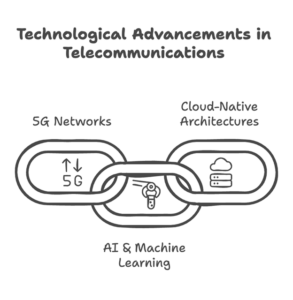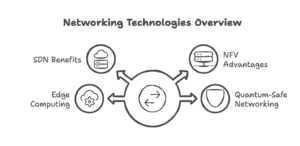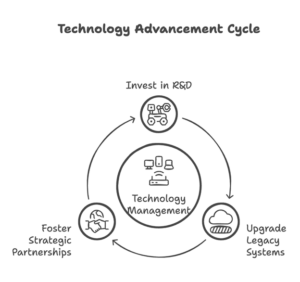The telecommunications landscape is constantly evolving, driven by new trends and innovative technologies. Network modification strategies must adapt to these advancements to remain competitive and deliver exceptional performance. This page explores the most impactful network modification trends and technologies shaping the future of network modification.
Key Emerging Trends in Network Modification
While many companies just focus on the basics of network modification, at DataField we look to the future as well. Understanding emerging trends helps organizations align their network strategies with industry advancements and customer expectations.
Rise of 5G Networks
5G technology is revolutionizing telecommunications, offering faster speeds, lower latency, and enhanced connectivity for IoT and edge computing applications.
- Enables real-time data processing for smart cities and autonomous vehicles.
- Supports massive device connectivity with high reliability.
Increased Adoption of AI and Machine Learning
AI and machine learning are transforming network management by automating processes and enabling predictive insights.
- Optimizes resource allocation and improves traffic management.
- Detects and resolves issues proactively through predictive analytics.
Transition to Cloud-Native Architectures
Cloud-native solutions are becoming a cornerstone of modern network infrastructures, enabling greater flexibility and scalability.
- Facilitates seamless integration with advanced technologies.
- Reduces hardware dependency and operational costs.

Breakthrough Technologies Driving Network Modification
Innovative technologies are at the heart of modern network modification efforts. Leveraging these advancements ensures networks remain efficient and future-ready. At DataField, we work these emerging technologies into every component of network modification to ensure your network is set for the future.
Software-Defined Networking (SDN)
SDN decouples the control plane from the data plane, enabling centralized and dynamic network management.
- Simplifies network configuration and reduces deployment times.
- Enhances flexibility to adapt to changing traffic patterns.
Network Function Virtualization (NFV)
NFV replaces hardware-based functions with virtualized equivalents, offering network modification cost savings and faster deployment.
- Reduces reliance on specialized hardware.
- Scales services quickly to meet changing demands.
Edge Computing
Edge computing processes data closer to its source, reducing latency and improving performance for critical applications.
- Supports low-latency applications like augmented reality and real-time analytics.
- Enhances IoT device performance and reliability.
Quantum-Safe Networking
As quantum computing evolves, networks must adopt quantum-resistant technologies to ensure long-term security.
- Implements post-quantum cryptography to protect sensitive data.
- Prepares networks for future quantum advancements.

Strategies for Embracing Emerging Trends and Technologies
To fully leverage new trends and technologies, organizations must adopt strategic approaches that align with their operational goals while balancing network modification compliance requirements.
Invest in R&D
Research and development efforts are crucial for staying ahead of technological advancements.
- Explore pilot projects for emerging technologies like SDN and NFV.
- Partner with academic institutions and industry leaders.
Upgrade Legacy Systems
Modernizing outdated infrastructure ensures compatibility with new technologies and improved efficiency.
- Replace legacy hardware with cloud-native and virtualized solutions.
- Conduct regular audits to identify upgrade opportunities.
Foster Strategic Partnerships
Collaborating with technology providers and industry experts accelerates the adoption of new trends.
- Engage with SDN and NFV solution providers.
- Participate in industry consortiums to share knowledge and best practices.

Real-World Example: Implementing Emerging Technologies
A global telecom provider adopted SDN and edge computing to optimize network performance. By leveraging these technologies, they:
- Reduced latency by 30% for real-time applications.
- Improved network scalability to accommodate a 50% increase in traffic.
- Lowered operational costs by 25% through virtualization.
Staying Ahead in a Rapidly Evolving Landscape
Emerging trends and technologies are redefining network modification strategies. By embracing innovations like 5G, AI, and edge computing, organizations can build efficient, secure, and scalable networks that meet future demands and overcome network modification challenges.

